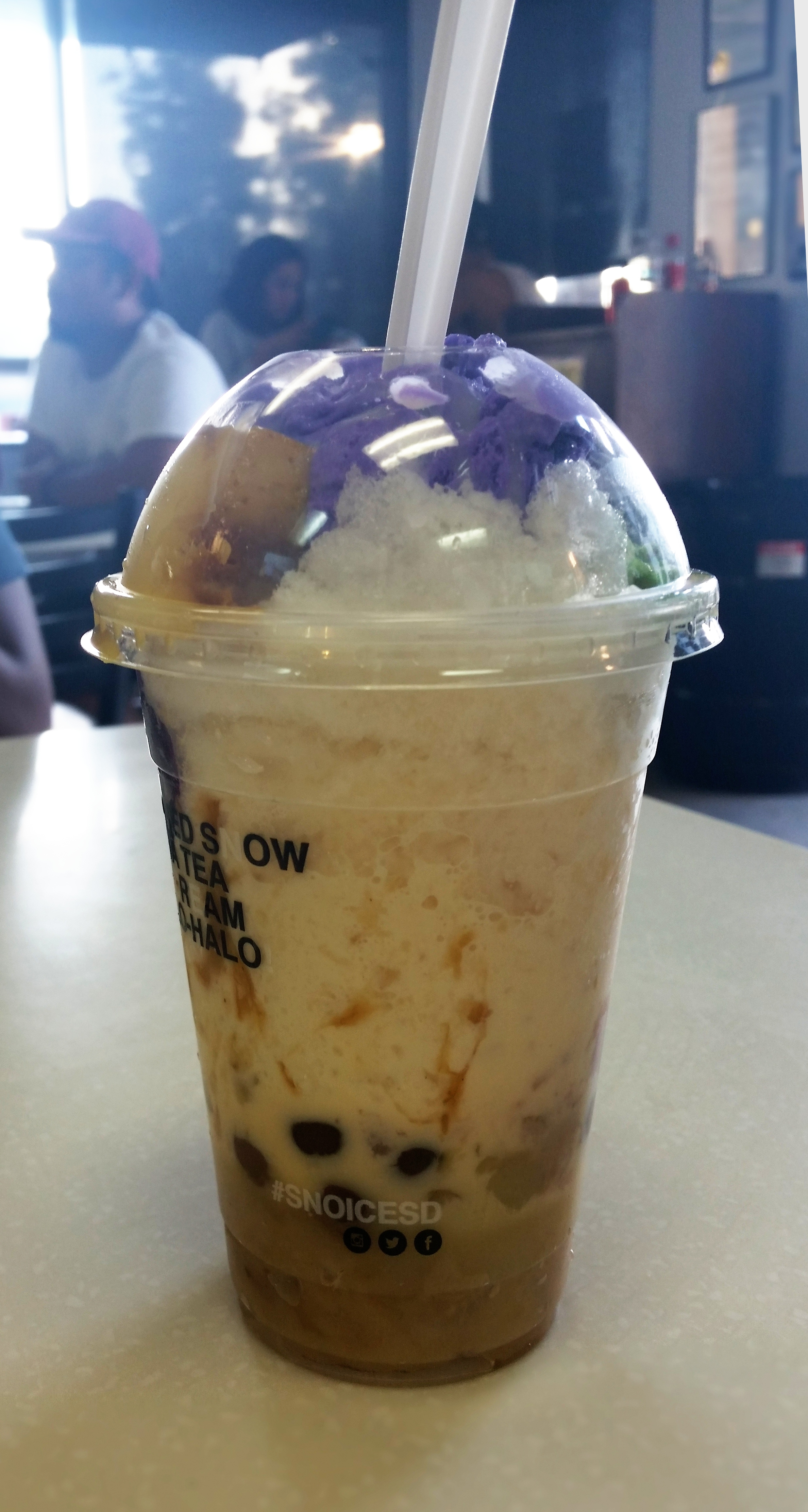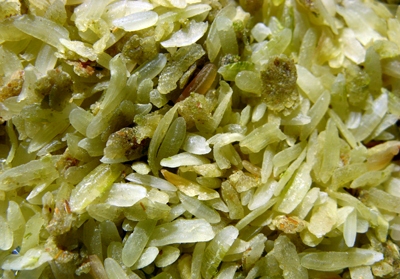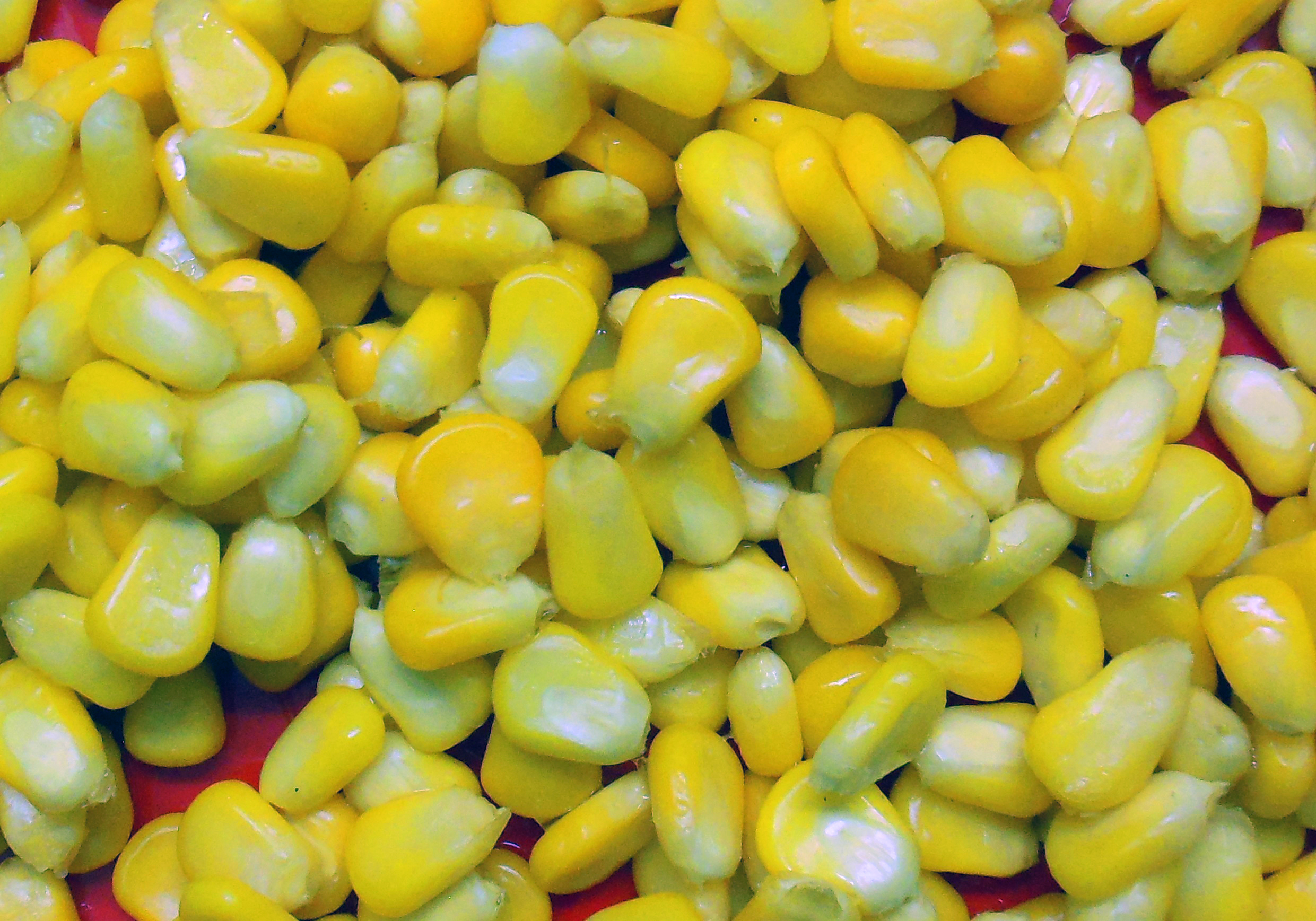|
Halo Halo
Halo-halo, correctly spelled ''haluhalo'', Tagalog for "mixed" (the more common spelling instead literally equating to "mix-mix") is a popular cold dessert in the Philippines made up of crushed ice, evaporated milk or coconut milk, and various ingredients including ube jam (ube halaya), sweetened kidney or garbanzo beans, coconut strips, sago, ''gulaman'' ( agar), pinipig, boiled taro or soft yams in cubes, flan, slices or portions of fruit preserves and other root crop preserves. The dessert is topped with a scoop of ube ice cream. It is usually prepared in a tall clear glass and served with a long spoon. ''Halo-halo'' is considered to be the unofficial national dessert of the Philippines. The term "''halo-halo''" is supposed to mean "mixed" in English because the dessert is meant to be mixed before being consumed. Although strictly grammatically incorrect, this spelling has come to describe any object or situation composed of a similar, colorful combination of ingredient ... [...More Info...] [...Related Items...] OR: [Wikipedia] [Google] [Baidu] |
Philippines
The Philippines (; fil, Pilipinas, links=no), officially the Republic of the Philippines ( fil, Republika ng Pilipinas, links=no), * bik, Republika kan Filipinas * ceb, Republika sa Pilipinas * cbk, República de Filipinas * hil, Republika sang Filipinas * ibg, Republika nat Filipinas * ilo, Republika ti Filipinas * ivv, Republika nu Filipinas * pam, Republika ning Filipinas * krj, Republika kang Pilipinas * mdh, Republika nu Pilipinas * mrw, Republika a Pilipinas * pag, Republika na Filipinas * xsb, Republika nin Pilipinas * sgd, Republika nan Pilipinas * tgl, Republika ng Pilipinas * tsg, Republika sin Pilipinas * war, Republika han Pilipinas * yka, Republika si Pilipinas In the recognized optional languages of the Philippines: * es, República de las Filipinas * ar, جمهورية الفلبين, Jumhūriyyat al-Filibbīn is an archipelagic country in Southeast Asia. It is situated in the western Pacific Ocean and consists of around 7,641 islands t ... [...More Info...] [...Related Items...] OR: [Wikipedia] [Google] [Baidu] |
Pinipig
''Pinipig'' is a flattened rice ingredient from the Philippines. It is made of immature grains of glutinous rice pounded until flat before being toasted. It is commonly used as toppings for various desserts in Filipino cuisine, but can also be eaten plain, made into cakes, or mixed with drinks and other dishes. Production ''Pinipig'' is made solely from glutinous rice (''malagkit'' or "sticky" rice). The grains are harvested while still green. They are husked and the chaff is separated from the grain (traditionally using large flat winnowing baskets called ''bilao''). The resulting bright green kernels are then pounded in large wooden mortars and pestles until flat. They are then toasted dry on pans or baked until crisp. Description ''Pinipig'' are characteristically light green in color when fresh, but usually become yellowish white to brown when toasted. They superficially resemble grains of oats, and are often confused with puffed rice. The texture is crunchy on the exteri ... [...More Info...] [...Related Items...] OR: [Wikipedia] [Google] [Baidu] |
Saba Banana
Saba banana (pron. or ), is a triploid hybrid (ABB) banana cultivar originating from the Philippines. It is primarily a cooking banana, though it can also be eaten raw. It is one of the most important banana varieties in Philippine cuisine. It is also sometimes known as the "cardaba banana", though the latter name is more correctly applied to the cardava, a very similar cultivar also classified within the saba subgroup. Description Saba bananas have very large, robust pseudostems that can reach heights of . The trunk can reach diameters of . The trunk and leaves are dark blue-green in color. Like all bananas, each pseudostem flowers and bears fruits only once before dying. Each mat bears about eight suckers. The fruits become ready for harvesting 150 to 180 days after flowering, longer than other banana varieties. Each plant has a potential yield of per bunch. Typically, a bunch has 16 hands, with each hand having 12 to 20 fingers. Saba bananas grow best in well-drained, fert ... [...More Info...] [...Related Items...] OR: [Wikipedia] [Google] [Baidu] |
Sweet Corn
Sweet corn (''Zea mays'' convar. ''saccharata'' var. ''rugosa''), also called sugar corn and pole corn, is a variety of maize grown for human consumption with a high sugar content. Sweet corn is the result of a naturally occurring recessive mutation in the genes which control conversion of sugar to starch inside the endosperm of the corn kernel. Sweet corn is picked when still in the immature (milk stage) and prepared and eaten as a vegetable, rather than field corn, which is harvested when the kernels are dry and mature (dent stage). Since the process of maturation involves converting sugar to starch, sweet corn stores poorly and must be eaten fresh, canned, or frozen, before the kernels become tough and starchy. It is one of the six major types of maize, the others being dent corn, flint corn, pod corn, popcorn, and flour corn. According to the USDA, 100 grams of raw yellow sweet corn contains 3.43 g glucose, 1.94 g fructose, and 0.89 g sucrose. History I ... [...More Info...] [...Related Items...] OR: [Wikipedia] [Google] [Baidu] |
Japan
Japan ( ja, 日本, or , and formally , ''Nihonkoku'') is an island country in East Asia. It is situated in the northwest Pacific Ocean, and is bordered on the west by the Sea of Japan, while extending from the Sea of Okhotsk in the north toward the East China Sea, Philippine Sea, and Taiwan in the south. Japan is a part of the Ring of Fire, and spans Japanese archipelago, an archipelago of List of islands of Japan, 6852 islands covering ; the five main islands are Hokkaido, Honshu (the "mainland"), Shikoku, Kyushu, and Okinawa Island, Okinawa. Tokyo is the Capital of Japan, nation's capital and largest city, followed by Yokohama, Osaka, Nagoya, Sapporo, Fukuoka, Kobe, and Kyoto. Japan is the List of countries and dependencies by population, eleventh most populous country in the world, as well as one of the List of countries and dependencies by population density, most densely populated and Urbanization by country, urbanized. About three-fourths of Geography of Japan, the c ... [...More Info...] [...Related Items...] OR: [Wikipedia] [Google] [Baidu] |
Adzuki Bean
''Vigna angularis'', also known as the adzuki bean , azuki bean, aduki bean, red bean, or red mung bean, is an Annual plant, annual vine widely cultivated throughout East Asia for its small (approximately long) bean. The cultivars most familiar in East Asia have a uniform red color, but there are also white, Black adzuki bean, black, gray, and variously mottled varieties. Scientists presume ''Vigna angularis'' var. ''nipponensis'' is the progenitor. Origin and diversity Speciation and domestication The wild ancestor of cultivated adzuki bean is probably ''Vigna angularis'' var. ''nipponensis'', which is distributed across Japan, Korea, China, Nepal and Bhutan. Speciation between ''Vigna angularis'' var. ''nipponensis'' and ''Vigna angularis'' var. ''angularis'' occurred around years ago. Archaeologists estimate it was domesticated around 3000 BC. However, adzuki beans (as well as soybeans) dating from 3000 BC to 2000 BC are indicated to still be largely within the wild si ... [...More Info...] [...Related Items...] OR: [Wikipedia] [Google] [Baidu] |
Mung Bean
The mung bean (''Vigna radiata''), alternatively known as the green gram, maash ( fa, ماش٫ )٫ mūng (), monggo, or munggo (Philippines), is a plant species in the legume family.Brief Introduction of Mung Bean. Vigna Radiata Extract Green Mung Bean Extract Powder Phaseolus aureus Roxb Vigna radiata L R Wilczek. MDidea-Extracts Professional. P054. http://www.mdidea.com/products/proper/proper05402.html The mung bean is mainly cultivated in East, Southeast and South Asia. It is used as an ingredient in both savoury and sweet dishes. Description The green gram is an annual vine with yellow flowers and fuzzy brown pods. The English word ''mung'' originated from the Hindi word (), which is derived from the Sanskrit word (). Morphology Mung bean (''Vigna radiata'') is a plant species of Fabaceae which is also known as green gram. It is sometimes confused with black gram (''Vigna mungo'') for their similar morphology, though they are two different species. The gree ... [...More Info...] [...Related Items...] OR: [Wikipedia] [Google] [Baidu] |
Kakigōri
is a Japanese shaved ice dessert flavored with syrup and a sweetener, often condensed milk.新明解国語辞典(第6版)、三省堂 History The origins of ''kakigōri'' date back to the Heian period in Japanese history, when blocks of ice saved during the colder months would be shaved and served with sweet syrup to Japanese aristocracy during the summer. Kakigōri's origin is referred to in ''The Pillow Book'', a book of observations written by Sei Shōnagon, who served the Imperial Court during the Heian period. Kakigōri became more accessible in the 19th century, when ice became more widely available to the public during the summertime. The first kakigōri store is believed to have opened in Yokohama in 1869. July 25 is known as kakigōri day in Japan because of its pronunciation sounding similar to summer ice in Japanese. Another reasoning for July 25 being kakigōri day is because, on that day in 1933, there was a record high temperature in Japan. Description The tr ... [...More Info...] [...Related Items...] OR: [Wikipedia] [Google] [Baidu] |
Japanese In The Philippines
Japanese settlement in the Philippines or Japanese Filipino, refers to one of the largest branches of Japanese diaspora having historical contact with and having established themselves in what is now the Philippines. This also refers to Filipino citizens of either pure or mixed Japanese descent currently residing in the country, the latter a result of intermarriages between the Japanese and local populations. History Classical period Settlements After the establishment of a single state within Japan, official trade records began between Japan and the Philippine islands in the Heian and Muromachi period (8th to 12th centuries CE). In the case of the proto-Okinawan chiefdoms, this was much earlier, and ties in with shared migration patterns of Okinawans and Austronesian areas like the Philippines stretching back to the neolithic period. Notable settlements of the period include Bolinao and Agoo along Lingayen Gulf. The Japanese were trading with Philippine kingdoms well before th ... [...More Info...] [...Related Items...] OR: [Wikipedia] [Google] [Baidu] |
American Colonization Of The Philippines
American(s) may refer to: * American, something of, from, or related to the United States of America, commonly known as the "United States" or "America" ** Americans, citizens and nationals of the United States of America ** American ancestry, people who self-identify their ancestry as "American" ** American English, the set of varieties of the English language native to the United States ** Native Americans in the United States, indigenous peoples of the United States * American, something of, from, or related to the Americas, also known as "America" ** Indigenous peoples of the Americas * American (word), for analysis and history of the meanings in various contexts Organizations * American Airlines, U.S.-based airline headquartered in Fort Worth, Texas * American Athletic Conference, an American college athletic conference * American Recordings (record label), a record label previously known as Def American * American University, in Washington, D.C. Sports teams Soccer * Ba ... [...More Info...] [...Related Items...] OR: [Wikipedia] [Google] [Baidu] |
Ube Ice Cream
Ube ice cream is a Filipino ice cream flavor prepared using ube (purple yam) as the main ingredient. This ice cream is often used in making the dessert halo-halo. History Due to its vivid violet color and mildly sweet and nutty taste, ube has been a staple of Filipino desserts, most notably ube halaya. The earliest recorded use of ube in ice cream was in a recipe from 1922, when ice cream's introduction to Filipino culture during the American occupation (as the local adaptation sorbetes) led to new flavors such as mango, pinipig and melon. The recipe called for mashed ube, milk, sugar and crushed ice. During that time, ice cream was also hand-churned in a ''garapinyera'', a manually operated ice cream mixer. Ube ice cream has risen in popularity outside the Philippines, due to its use by Filipino immigrants in restaurants (often with halo-halo) and Trader Joe's line of ube products, its vivid violet color and the spread of its pictures on social media. Use in halo-halo U ... [...More Info...] [...Related Items...] OR: [Wikipedia] [Google] [Baidu] |
Fruit Preserves
Fruit preserves are preparations of fruits whose main preserving agent is sugar and sometimes acid, often stored in glass jars and used as a condiment or spread. There are many varieties of fruit preserves globally, distinguished by the method of preparation, type of fruit used, and place in a meal. Sweet fruit preserves such as jams, jellies, and marmalades are often eaten at breakfast with bread or as an ingredient of a pastry or dessert, whereas more savory and acidic preserves made from " vegetable fruits" such as tomato, squash or zucchini, are eaten alongside savory foods such as cheese, cold meats, and curries. Techniques There are several techniques of making jam, with or without added water. One factor depends on the natural pectin content of the ingredients. When making jam with low pectin fruits like strawberries either high pectin fruit like orange can be added, or additional pectin in the form of pectin powder, citric acid or citrus peels. Often the fruit will be ... [...More Info...] [...Related Items...] OR: [Wikipedia] [Google] [Baidu] |






